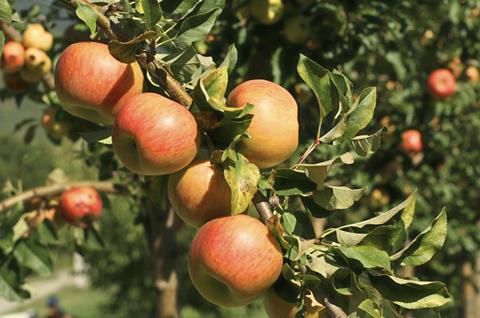Despite considerable challenges, Daniel Sauvaitre, president of the French apple and pear association (ANPP), believes the country’s apple business is well placed to respond to consumer demands for sustainability and top quality

As June came to an end, Europe’s relentless heatwave continued unabated. A so-called heat dome settled over the continent, bringing sweltering temperatures of 40C-plus to much of France and forcing the closure of hundreds of schools and even the Eiffel Tower. Meanwhile, a touring ‘Heat Chamber’, run by the Human Adaptation Institute as a way of raising awareness of climate change, roamed the streets of France, offering the opportunity for people to experience what life would be like at a whopping 50C.
This heat is a big challenge for apple growers, says Daniel Sauvaitre, president of ANPP (Association Nationale Pommes Poires), and a grower himself. When the sector gathers for August’s Prognosfruit 2025 in the French city of Angers, most growers will be hoping for cooler climes.
“We are not used to having such high temperatures so early in the year,” says Sauvaitre. “It is creating a lot of stress for the whole agricultural sector – the heat and the lack of rain. But French apple growers experienced good flowering and fruit set, so the potential seems quite normal. We could have a crop close to that of 2024. But it is too early to predict.”
A balancing act
The summer is certain to present new challenges, of course, and Sauvaitre points out that France’s apple growers are operating with fewer tools in the plant protection toolkit than in the past. “Ten years ago, there were products that we could rely on to protect our crops – against pests, fungi, disease,” he says. “Now, many of those have been banned. That creates a lot of stress on production, but it also forces innovation.”
For Sauvaitre, it is important to recognise that French growers have been central to that innovation in recent decades, starting with ‘integrated fruit production’ in the 1990s before shifting to agroecology and ecoresponsible orchards and, increasingly today, regenerative farming.

“Regenerative farming is a nice term,” he says, “but it’s really nothing new. When you are a farmer, you take care of your soil. You want it to be healthy, with a good humus content and balance of elements, you want to put all the wood from the trees you are pruning back into the soil. An apple grower that is not regenerative, whose soil is getting poorer and poorer – economically, that’s fatal. We have been experimenting for decades and we will continue to improve how we produce.
“In France, we are at a good level today. Farmers and apple growers continuously improve the way they are producing. But with more and more phytosanitary products being restricted, it is becoming difficult to get a good crop. This year, grey aphids have been a big problem. In most countries it’s easy to get rid of them, but not in France. There are active substances we can use but they’re not as effective, which puts us at a disadvantage.”
Sauvaitre says growers face a similar issue when it comes to water. “In France, we have plenty of water sometimes, so we believe we need to store more,” he says. “But in France it’s impossible to speak about increasing our water storage capacity. With summer temperatures rising, we will need more water than before in the apple sector, but it’s political.”
Political impacts
Finding sufficient labour is also becoming a greater challenge each year, not just in France but all over Europe and the US. “To pick, to prune, we need seasonal workers, and in the French orchards, they are not easy to find,” he explains. “We need workers from other countries in Europe and North Africa, but this is becoming increasingly difficult. There is a global fight on to maintain a good balance in terms of seasonal workers and being able to keep fresh fruit on the shelves.”
These challenges come at a time when the sector is also contending with the knock-on effects of global political instability and trade disruption. Reaching Asia is more difficult, with containers circumventing South Africa to avoid the Red Sea issues. But despite difficulties, exporters are seeing good results in places like Vietnam, which has grown into the top market for French apples in the region..
French exports continue to average around 300,000 tonnes annually, with the UK remaining a strong partner and growth also being seen in Latin America. “We thought Brexit might make things difficult, but the UK remains the top market for French apples,” says Sauvaitre. “Mexico has now decided to diversify its import origins due to trade issues with the US, and that has opened the door for France. We had been waiting 25 years to enter the Mexican market, and Trump has helped us with that. We’re hopeful we’ll begin exporting there as early as next season. We’ve also had good results in South America, including in Colombia and Brazil.”



